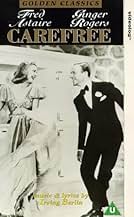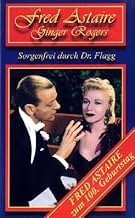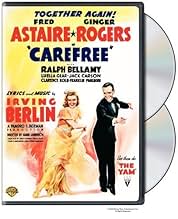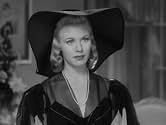VALUTAZIONE IMDb
6,9/10
4508
LA TUA VALUTAZIONE
Aggiungi una trama nella tua linguaA psychiatrist falls in love with the woman he's supposed to be nudging into marriage with someone else.A psychiatrist falls in love with the woman he's supposed to be nudging into marriage with someone else.A psychiatrist falls in love with the woman he's supposed to be nudging into marriage with someone else.
- Regia
- Sceneggiatura
- Star
- Candidato a 3 Oscar
- 3 vittorie e 4 candidature totali
The Robert Mitchell Boy Choir
- Vocal Ensemble
- (scene tagliate)
- (as Robert B. Mitchell and his St. Brendan's Boys)
Harry A. Bailey
- Sponsor
- (non citato nei titoli originali)
Bobby Barber
- Minor Role
- (non citato nei titoli originali)
Cliff Bergere
- Minor Role
- (non citato nei titoli originali)
Ralph Brooks
- Country Club Guest
- (non citato nei titoli originali)
James P. Burtis
- Glass Truck Driver
- (non citato nei titoli originali)
Harry Campbell
- Minor Role
- (non citato nei titoli originali)
James Carlisle
- Country Club Guest
- (non citato nei titoli originali)
Charles Coleman
- Doorman
- (non citato nei titoli originali)
Recensioni in evidenza
CAREFREE (RKO Radio, 1938), directed by Mark Sandrich, a screwball comedy set to music, reunites the song and dance team of Fred Astaire and Ginger Rogers for the eighth time in a sort of welcome change from their previous efforts: Astaire plays a doctor, psychiatrist by profession, rather than his usual lovesick American dancer, although the doctor in question DOES have a talent for dancing. Rogers, breaking away from sophisticated humor, makes her mark in broader comedy. She's been funny before, usually sassy with nifty comebacks, but this time in the dizzy-dame mode, but fortunately, not to the extreme.
The plot focuses on Stephen Arden (Ralph Bellamy), a witless attorney. He becomes drunk after his engagement to popular radio star, Amanda Cooper (Ginger Rogers), has been broken for the third time and stumbles to the Medical Foundation building to ask his good friend, Dr. Tony Flagg (Fred Astaire), a psychiatrist assisted by his white coated Connors (Jack Carson), to have Amanda "what's 'er name" analyzed. While waiting in his office, Amanda, accidentally stumbles upon Flagg's phonograph record, listening to a diagnosis about his last patient, closing with his comment about his next patient, Miss Cooper, being a "maladjusted woman." Upset, Amanda turns the tables around by sitting behind his desk and the doctor uncomfortably on the other end in a question and answer session. While bicycling in the park with Steven and her Aunt Cora (Luella Gaer), Amanda and Tony meet again, coming come to friendly terms. Agreeing to Tony's treatments, Amanda goes through a dinner special diet (lobster with mayonnaise and buttermilk) so to have her dreams analyzed, and hypnotism that turns to disaster when roaming the streets in a trance.
With plenty of comedy written into the screenplay, it's a wonder how dance numbers could fit into an overall "screwball" comedy, especially with a score by Irving Berlin. This is where CAREFREE stands apart from the other Astaire and Rogers films. The first number, "Since They Turned 'Loch Lamond' Into Swing" finds Astaire at a golf course accomplishing several things at the same time by playing the harmonica and tap dancing to a Scottish underscoring while teeing off several golf balls in rhythm, all to perfection without once missing his mark. There is no vocal to this number. "I Used to Be Color Blind" is very interesting mainly because it takes part as Rogers' dream dance, with Astaire, singing and dancing in slow motion. While "The Yam" sung by Ginger Rogers at the country club, is an upbeat number, followed by dancing with Astaire on wooden floors rather than the traditional glossy ones. It didn't become a memorable duet as "The Carioca," "The Continental" or "The Piccolino," but unlike these earlier dance numbers, which Fred and Ginger are the main focus, they invite dinner guests to join in with them. The final number, "Change Partners," a more appropriate title than "Carefree," is a beautiful love dance, or trance dance, where the hypnotized Rogers dances in a motionless manner with Astaire. While "Change Partners" is in slower tempo, it's one of the film's most memorable tune, it not, their most sentimental dance sequences. "Change Partners" earned an Academy Award nomination as Best Song.
Luella Gear, as Rogers' matron aunt, Cora, comes across as a middle-aged Kay Francis but speaking like Helen Broderick. Gear, in her movie debut, had very few films to her credit. She's reportedly best known for her role as Aunt Hortence in the stage version of THE GAY DIVORCE (1932) that starred Astaire. Ralph Bellamy, who by this time was usually type-cast as stuffy suitors, happens to be the most masculine of Rogers' rejected beaus thus far. His character, however, becomes very unlikable towards the second half, bogging down the story.
Rounding out the cast in smaller roles are Franklin Pangborn (Roland Hunter); and Hattie McDaniel (Hattie, the maid); and Kay Sutton (Miss Adams). Clarence Kolb takes support as the no-nonsense Judge Joe Travers, Stephen's friend who pleasure himself by telling corny jokes. Although credited, the Robert B. Mitchell and the St. Brendan's Boy Choir seem to have become victims of the editing process consider how they're nowhere to be seen, only heard on the soundtrack singing "Change Partners" near the film's close.
In spite of numerous pros and cons, CAREFREE ranks the team's most underrated film as shortest (83 minutes). It's occasionally funny in spots with imaginable, if not too successful, dance numbers. Other than CAREFREE being available on video cassette and DVD, and formerly found on American Movie Classics prior to 2001, it turns up occasionally (with close casting credits restored) on Turner Classic Movies. Next in the Astaire and Rogers series, THE STORY OF VERNON AND IRENE CASTLE (1939). (***)
The plot focuses on Stephen Arden (Ralph Bellamy), a witless attorney. He becomes drunk after his engagement to popular radio star, Amanda Cooper (Ginger Rogers), has been broken for the third time and stumbles to the Medical Foundation building to ask his good friend, Dr. Tony Flagg (Fred Astaire), a psychiatrist assisted by his white coated Connors (Jack Carson), to have Amanda "what's 'er name" analyzed. While waiting in his office, Amanda, accidentally stumbles upon Flagg's phonograph record, listening to a diagnosis about his last patient, closing with his comment about his next patient, Miss Cooper, being a "maladjusted woman." Upset, Amanda turns the tables around by sitting behind his desk and the doctor uncomfortably on the other end in a question and answer session. While bicycling in the park with Steven and her Aunt Cora (Luella Gaer), Amanda and Tony meet again, coming come to friendly terms. Agreeing to Tony's treatments, Amanda goes through a dinner special diet (lobster with mayonnaise and buttermilk) so to have her dreams analyzed, and hypnotism that turns to disaster when roaming the streets in a trance.
With plenty of comedy written into the screenplay, it's a wonder how dance numbers could fit into an overall "screwball" comedy, especially with a score by Irving Berlin. This is where CAREFREE stands apart from the other Astaire and Rogers films. The first number, "Since They Turned 'Loch Lamond' Into Swing" finds Astaire at a golf course accomplishing several things at the same time by playing the harmonica and tap dancing to a Scottish underscoring while teeing off several golf balls in rhythm, all to perfection without once missing his mark. There is no vocal to this number. "I Used to Be Color Blind" is very interesting mainly because it takes part as Rogers' dream dance, with Astaire, singing and dancing in slow motion. While "The Yam" sung by Ginger Rogers at the country club, is an upbeat number, followed by dancing with Astaire on wooden floors rather than the traditional glossy ones. It didn't become a memorable duet as "The Carioca," "The Continental" or "The Piccolino," but unlike these earlier dance numbers, which Fred and Ginger are the main focus, they invite dinner guests to join in with them. The final number, "Change Partners," a more appropriate title than "Carefree," is a beautiful love dance, or trance dance, where the hypnotized Rogers dances in a motionless manner with Astaire. While "Change Partners" is in slower tempo, it's one of the film's most memorable tune, it not, their most sentimental dance sequences. "Change Partners" earned an Academy Award nomination as Best Song.
Luella Gear, as Rogers' matron aunt, Cora, comes across as a middle-aged Kay Francis but speaking like Helen Broderick. Gear, in her movie debut, had very few films to her credit. She's reportedly best known for her role as Aunt Hortence in the stage version of THE GAY DIVORCE (1932) that starred Astaire. Ralph Bellamy, who by this time was usually type-cast as stuffy suitors, happens to be the most masculine of Rogers' rejected beaus thus far. His character, however, becomes very unlikable towards the second half, bogging down the story.
Rounding out the cast in smaller roles are Franklin Pangborn (Roland Hunter); and Hattie McDaniel (Hattie, the maid); and Kay Sutton (Miss Adams). Clarence Kolb takes support as the no-nonsense Judge Joe Travers, Stephen's friend who pleasure himself by telling corny jokes. Although credited, the Robert B. Mitchell and the St. Brendan's Boy Choir seem to have become victims of the editing process consider how they're nowhere to be seen, only heard on the soundtrack singing "Change Partners" near the film's close.
In spite of numerous pros and cons, CAREFREE ranks the team's most underrated film as shortest (83 minutes). It's occasionally funny in spots with imaginable, if not too successful, dance numbers. Other than CAREFREE being available on video cassette and DVD, and formerly found on American Movie Classics prior to 2001, it turns up occasionally (with close casting credits restored) on Turner Classic Movies. Next in the Astaire and Rogers series, THE STORY OF VERNON AND IRENE CASTLE (1939). (***)
Carefree marked the third collaboration of Fred Astaire and Ginger Rogers singing and dancing to an Irving Berlin score. Unfortunately it would prove to be the weakest of the films, the others being Top Hat and Follow The Fleet. One thing was that Irving Berlin wrote a lot less music for this than the other two.
The second thing was that it involved psychiatry and we'd have to wait for such musicals as Lady in the Dark and On A Clear Day before the subject was handled in any way responsibly.
I'm not sure the subject was the proper one for Astaire and Rogers. The plot has Rogers seeing Astaire professionally while she's engaged to Ralph Bellamy who is playing the typical Ralph Bellamy part. I guess because it's Ralph Bellamy liberties can be taken with the leading lady by a her psychiatrist.
It was a bit much to swallow, a man who gave up studying the dance to become a disciple of Sigmund Freud. But that's what Fred Astaire is in Carefree. Usually the two don't mix. I can't imagine Freud breaking out into an intricate Astaire dance routine.
I will say that Irving Berlin did give Fred and Ginger some good songs to sing and dance to. The print I have is totally black and white and the I Used To Be Color Blind dream sequence definitely loses something when not seen in color. Fred and Ginger are at their liveliest doing The Yam and the rest of the cast gets involved. In fact I was surprised at how nimble Clarence Kolb was on his feet.
Fred's plaintive plea for Ginger to Change Partners got an Oscar nomination for Best Song, but it lost to Bob Hope's perennial theme of Thanks for the Memory.
I could not quite enjoy Carefree as much I have other Astaire/Rogers collaborations. When you think about, Fred's using his professional training to mess with her mind. His heart may be in the right place, but his medical ethics stink.
The second thing was that it involved psychiatry and we'd have to wait for such musicals as Lady in the Dark and On A Clear Day before the subject was handled in any way responsibly.
I'm not sure the subject was the proper one for Astaire and Rogers. The plot has Rogers seeing Astaire professionally while she's engaged to Ralph Bellamy who is playing the typical Ralph Bellamy part. I guess because it's Ralph Bellamy liberties can be taken with the leading lady by a her psychiatrist.
It was a bit much to swallow, a man who gave up studying the dance to become a disciple of Sigmund Freud. But that's what Fred Astaire is in Carefree. Usually the two don't mix. I can't imagine Freud breaking out into an intricate Astaire dance routine.
I will say that Irving Berlin did give Fred and Ginger some good songs to sing and dance to. The print I have is totally black and white and the I Used To Be Color Blind dream sequence definitely loses something when not seen in color. Fred and Ginger are at their liveliest doing The Yam and the rest of the cast gets involved. In fact I was surprised at how nimble Clarence Kolb was on his feet.
Fred's plaintive plea for Ginger to Change Partners got an Oscar nomination for Best Song, but it lost to Bob Hope's perennial theme of Thanks for the Memory.
I could not quite enjoy Carefree as much I have other Astaire/Rogers collaborations. When you think about, Fred's using his professional training to mess with her mind. His heart may be in the right place, but his medical ethics stink.
Fred Astaire and Ginger Rogers star in this delightful romantic musical comedy with a twist on the usual Fred and Ginger plot. Though odd and short in the musical number department, this teasing romantic romp features some of their best dancing and good humor to boot. Ginger Rogers is nothing short of stunning in this picture and Mr. Astaire's feet never touch the ground. Definitely their most underrated film.
this is one of my favorite fred astaire/ginger rogers films. it's highly amusing how she toys with him at the beginning of the film, and then once he begins hypnosis, they have one of the best dance scenes i've ever seen between them. as always, their magic together is astounding.
there is something specific about watching fred astaire and ginger rogers that just makes you want to dance. i think it's because they make it look so damn fun. and they are just so astonishingly good!! the plot here is a tad crazier than, say "top hat", and therefore that much less believable (come on ... going all out with freud and hypnosis, but then again that's just speaking from what is known today, so no problem letting that pass). irving berlin's music is a hoot at times (there's a song about yams) and classic and familiar at others ("change partners") and ginger rogers is nearly at her sassy best.
Lo sapevi?
- QuizThis was the first Fred Astaire-Ginger Rogers film to lose money on its initial release. It lost $68,000 (~ $1.48M in 2024) for RKO according to studio records.
- BlooperIn the golf sequence, one of the five golf balls thrown on the solid base has rolled off onto the grass. After Fred has hit the first four balls, the camera cuts to a new angle and the last ball has moved from the grass to the solid base.
- Citazioni
Stephen Arden: [drunkenly] Oh, uh, could you give me a little information?
Doorman: Yes sir.
Stephen Arden: Thank you.
[walks away]
- Curiosità sui creditiDuring opening credits, a pair of hands finger-paints names, pauses, wipes them out, and writes the next set of names several times.
- ConnessioniFeatured in Fred Astaire: Puttin' on His Top Hat (1980)
- Colonne sonoreSince They Turned Loch Lomond into Swing
(1938) (uncredited)
Music by Irving Berlin
Danced by Fred Astaire
I più visti
Accedi per valutare e creare un elenco di titoli salvati per ottenere consigli personalizzati
- How long is Carefree?Powered by Alexa
Dettagli
Botteghino
- Budget
- 1.253.000 USD (previsto)
- Tempo di esecuzione1 ora 23 minuti
- Colore
- Proporzioni
- 1.37 : 1
Contribuisci a questa pagina
Suggerisci una modifica o aggiungi i contenuti mancanti


































